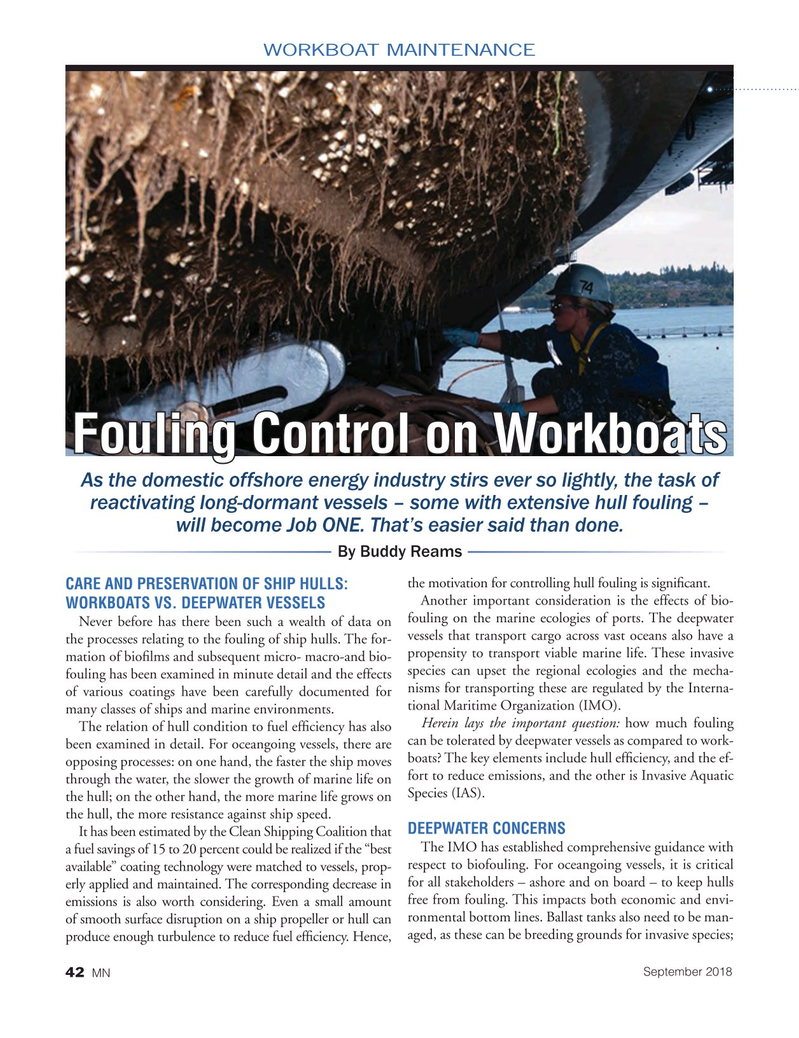
Page 42: of Marine News Magazine (September 2018)
Offshore Annual
Read this page in Pdf, Flash or Html5 edition of September 2018 Marine News Magazine
WORKBOAT MAINTENANCE
Fouling Control on WorkboatsFouling Control on Workboats
As the domestic offshore energy industry stirs ever so lightly, the task of reactivating long-dormant vessels – some with extensive hull fouling – will become Job ONE. That’s easier said than done.
By Buddy Reams the motivation for controlling hull fouling is signi? cant.
CARE AND PRESERVATION OF SHIP HULLS:
Another important consideration is the effects of bio-
WORKBOATS VS. DEEPWATER VESSELS
Never before has there been such a wealth of data on fouling on the marine ecologies of ports. The deepwater vessels that transport cargo across vast oceans also have a the processes relating to the fouling of ship hulls. The for- propensity to transport viable marine life. These invasive mation of bio? lms and subsequent micro- macro-and bio- fouling has been examined in minute detail and the effects species can upset the regional ecologies and the mecha- of various coatings have been carefully documented for nisms for transporting these are regulated by the Interna- tional Maritime Organization (IMO).
many classes of ships and marine environments.
Herein lays the important question: how much fouling
The relation of hull condition to fuel ef? ciency has also been examined in detail. For oceangoing vessels, there are can be tolerated by deepwater vessels as compared to work- opposing processes: on one hand, the faster the ship moves boats? The key elements include hull ef? ciency, and the ef- through the water, the slower the growth of marine life on fort to reduce emissions, and the other is Invasive Aquatic the hull; on the other hand, the more marine life grows on Species (IAS).
the hull, the more resistance against ship speed.
DEEPWATER CONCERNS
It has been estimated by the Clean Shipping Coalition that
The IMO has established comprehensive guidance with a fuel savings of 15 to 20 percent could be realized if the “best respect to biofouling. For oceangoing vessels, it is critical available” coating technology were matched to vessels, prop- erly applied and maintained. The corresponding decrease in for all stakeholders – ashore and on board – to keep hulls emissions is also worth considering. Even a small amount free from fouling. This impacts both economic and envi- of smooth surface disruption on a ship propeller or hull can ronmental bottom lines. Ballast tanks also need to be man- produce enough turbulence to reduce fuel ef? ciency. Hence, aged, as these can be breeding grounds for invasive species;
September 2018 42 MN
MN Sept18 Layout 32-49.indd 42 MN Sept18 Layout 32-49.indd 42 8/27/2018 4:10:51 PM8/27/2018 4:10:51 PM

 41
41

 43
43
